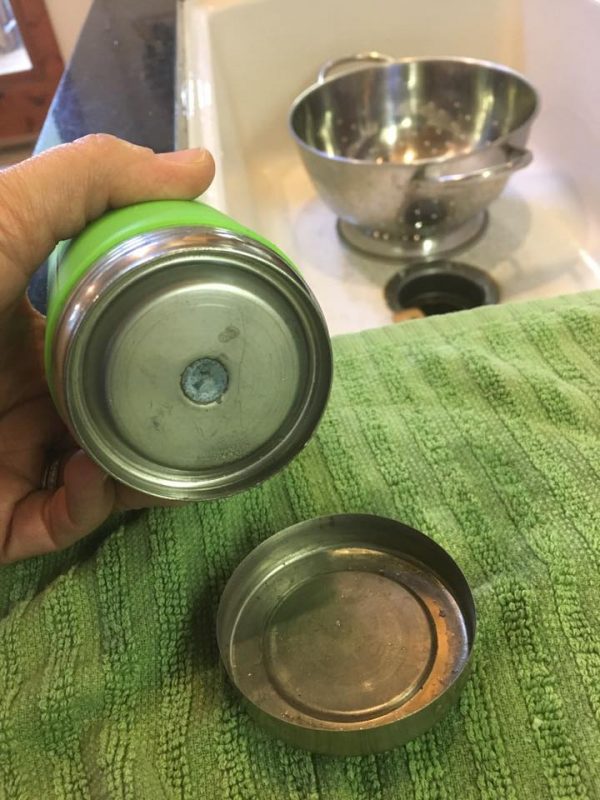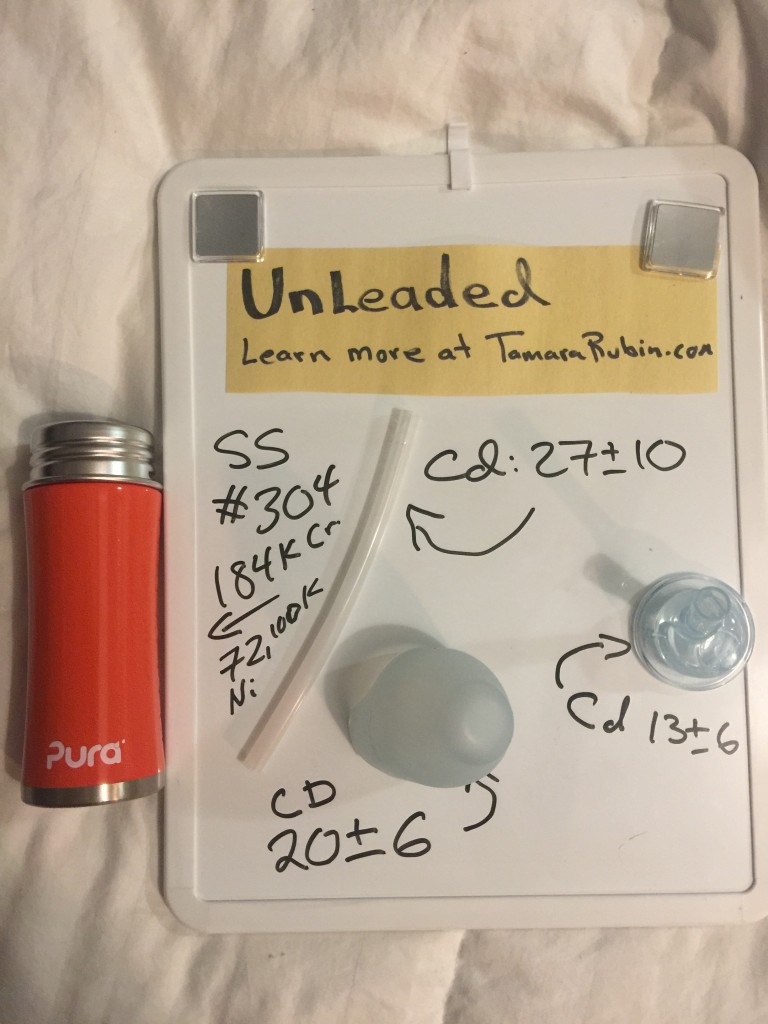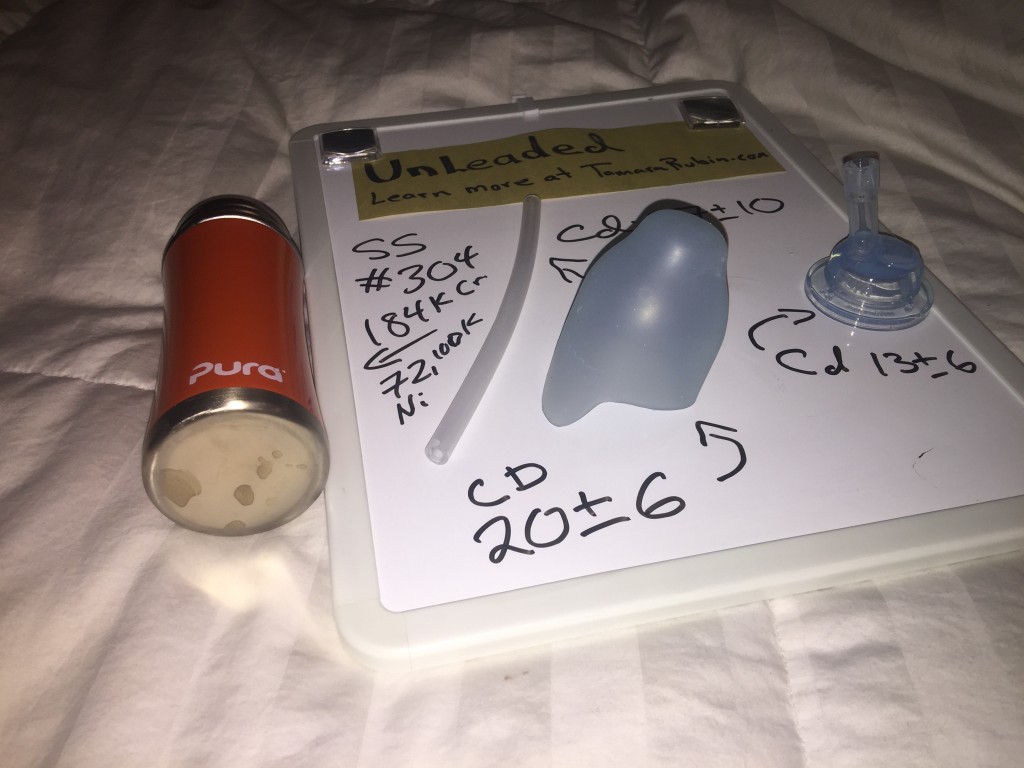#XRFTesting: Orange Pura Child’s Water Bottle
The silicone parts of this particular bottle tested positive for low/ trace cadmium.
Given I have been finding cadmium in more than 50% of silicone items I have tested, I conclude (just based on my observations) that this level of cadmium is likely naturally occurring in the materials being used to produce the silicone (it is not an added ingredient at these very low levels).
Additionally this level of cadmium is considered safe by all standards, however I still have concerns about it – as it is a known carcinogen and I have been finding it across the board in so many silicone products (both products intended for use by children and those intended for use by adults.)
I don’t know that any agency or organization is monitoring the impact of cadmium found so pervasively in these trace levels throughout the products in our home, and my concern is specifically that many of these items are kitchenware and /or intended for use by babies and young children.
Also interesting to note: I have tested many baby bottles with silicone components where these components were cadmium free, including the clear silicone nipples that come with the Avent bottles, so it is possible to manufacture silicone that is free of cadmium.
 Please note: some insulated stainless steel water bottles have tested positive for high levels of lead in the center sealing dot in the middle of the bottom of the bottle.
Please note: some insulated stainless steel water bottles have tested positive for high levels of lead in the center sealing dot in the middle of the bottom of the bottle.
IF there is lead under the bottom stainless steel cap of a water bottle like this the XRF is generally NOT able to detect it through the stainless steel.
However, I ask that you keep aware of the potential issue and notice (in the event that the bottom comes off) whether or not there is a darker metal sealing dot in the center of the bottom of the bottle, and if there is, discontinue use of the product.
Generally, in my experience, water bottles with the capped bottom like this (several brands have similar construction) do not appear to always/ consistently have a leaded sealing dot under the bottom stainless cap (a cap that covers the whole bottom and goes up the sides a bit). However I have not actually dissected new versions of these bottles to see if this is consistently the case.
May 2017 Update: with this particular brand ( Pura Kiki ) it appears that the insulated bottles DO have a lead dot on the bottom underneath the stainless cap. The company has made a promise to investigate this issue and make changes so their insulated bottles are lead-free in the future, but I have not yet seen evidence of this initiative. Click here to read more about lead found in Pura Kiki bottles.
In any event, with this type of construction, if there is a leaded sealing dot it is well covered an not accessible to children (until the bottom cap / base comes off, which apparently it often does with regular normal use by a child!)
I do NOT recommend this brand
and give this brand and company a “GRADE F”.
To read more about my concerns for trace cadmium in silicone click here. Please note that the hazard level for cadmium in an item intended for children is currently 40 parts per million and these levels are all below 40.
Here’s my #SaferChoices water bottle post too!
Click here for #SaferChoices for your family! • #XRFTesting
Some of the links on this page may be affiliate links where a purchase made
after clicking will support this website without costing you extra!
Affiliate link disclosure: If you choose to purchase any items after clicking the Amazon links above, Amazon pays me a small kick back as a thank you for sending business their way. It doesn’t cost you anything extra and helps support this website, allowing me to keep sharing information about childhood lead poisoning prevention (as well as making it possible for me to keep sharing about safe products for your home and family) ... Sharing this information in turn helps families everywhere protect their children from potential environmental toxicity in their homes. I only link to products that are the same as (or very similar to) ones that I either have direct personal experience with in my home or that I have personally tested with an XRF Instrument and found to be lead-safe or lead-free. March 2017
Never Miss an Important Article Again!
Join our Email List





Do you have any recommendations for a silicone straw cup for toddlers? Thank you!